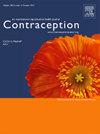社会剥夺指数和避孕护理的协会在全州范围内的避孕措施获得倡议。
IF 2.8
2区 医学
Q1 OBSTETRICS & GYNECOLOGY
引用次数: 0
摘要
目的:检查社会剥夺指数(SDI)和避孕护理在印第安纳州全州避孕获得倡议(PATH4YOU)的关系。研究设计:采用横断面分析的方法,研究参与者选择的预约类型和避孕方法与年龄和社会剥夺指数(SDI)的关系。结果:1201名参与者中,45.2%的人选择了短效避孕,76.9%的人接受了当面护理。与最低四分位数的参与者相比,SDI最高四分位数(最严重的社会剥夺)的参与者选择亲自护理(93.1%对63.4%)和长效避孕(62.8%对35.6%)。结论:参与者选择的预约类型和避孕方法与社会剥夺水平相关。含义:对印第安纳州全州避孕计划(PATH4YOU)中的预约类型和避孕方法进行了分析,并显示了基于社会剥夺四分位数的差异。那些生活在社会最贫困地区的人选择了亲自护理(相对于远程保健)和长效避孕措施。本文章由计算机程序翻译,如有差异,请以英文原文为准。
The association of social deprivation index and contraception care in a statewide contraceptive access initiative
Objectives
To examine the association of social deprivation index (SDI) and contraception care in a statewide contraceptive access initiative (PATH4YOU) in Indiana.
Study design
A cross-sectional analysis was performed to examine associations of participant’s chosen appointment type and contraceptive method with age and SDI.
Results
Of the 1201 participants, 45.2% chose a short-acting contraception, 76.9% received in-person care. Those within the highest SDI quartile (greatest social deprivation) chose in-person care (93.1% vs. 63.4%) and long-acting contraception (62.8% vs. 35.6%) when compared to participants within the lowest quartile (p < 0.01). This was confirmed by multivariable analysis, which showed that as SDI quartiles increased, OR for in-person care and long-acting contraception increased.
Conclusions
Participant chosen type of appointment and contraceptive method were associated with levels of social deprivation.
Implications
Analysis of appointment type and contraceptive method within a statewide contraceptive initiative in Indiana (PATH4YOU) was done and showed differences based on social deprivation quartiles. Those living in geographic areas of greatest social deprivation chose in-person care (vs. telehealth) and long-acting contraception.
求助全文
通过发布文献求助,成功后即可免费获取论文全文。
去求助
来源期刊

Contraception
医学-妇产科学
CiteScore
4.70
自引率
17.20%
发文量
211
审稿时长
69 days
期刊介绍:
Contraception has an open access mirror journal Contraception: X, sharing the same aims and scope, editorial team, submission system and rigorous peer review.
The journal Contraception wishes to advance reproductive health through the rapid publication of the best and most interesting new scholarship regarding contraception and related fields such as abortion. The journal welcomes manuscripts from investigators working in the laboratory, clinical and social sciences, as well as public health and health professions education.
 求助内容:
求助内容: 应助结果提醒方式:
应助结果提醒方式:


